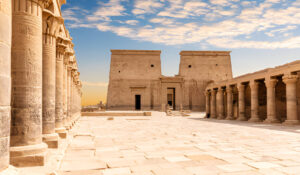Nestled along the banks of the Nile River in southern Egypt, Luxor and Aswan are two of the country’s most remarkable destinations, known for their rich history, stunning desert landscapes, and breathtaking ancient monuments. These cities, once at the heart of ancient Egyptian civilization, offer visitors a unique journey through time, set against the backdrop of the vast desert and the flowing Nile.
Luxor: The World’s Greatest Open-Air Museum
Luxor, often called the world’s greatest open-air museum, is home to some of Egypt’s most famous archaeological wonders. The city, once known as Thebes, was the capital of Egypt during the New Kingdom (1550–1070 BCE) and played a central role in the country’s religious and political life.

The Temples of Luxor and Karnak
One of the most iconic sites in Luxor is the Karnak Temple Complex, the largest religious site in ancient Egypt. This vast temple, dedicated to the god Amun, features massive pylons, towering columns, and the famous Hypostyle Hall, a forest of 134 enormous stone columns that leave visitors in awe. The Luxor Temple, located in the heart of the city, is another architectural masterpiece that once connected to Karnak by the Avenue of Sphinxes, an ancient ceremonial road lined with hundreds of statues.
The Valley of the Kings and Valley of the Queens
Across the Nile, on Luxor’s West Bank, lies the Valley of the Kings, where pharaohs of the New Kingdom, including Tutankhamun, were buried in elaborately decorated tombs carved deep into the desert hills. Nearby, the Valley of the Queens houses the tombs of royal women, including the stunning Tomb of Queen Nefertari, considered one of the most beautifully preserved tombs in Egypt.
Hatshepsut’s Temple and the Colossi of Memnon
One of Luxor’s most striking monuments is the Mortuary Temple of Hatshepsut, built by Egypt’s most famous female pharaoh. Its elegant terraces and colonnades rise dramatically against the desert cliffs. Not far from the temple stand the Colossi of Memnon, two massive stone statues of Pharaoh Amenhotep III that have stood for over 3,400 years, guarding what was once a magnificent temple.
Aswan: The Jewel of the Nile
Located further south, Aswan is a city known for its tranquil beauty, Nubian heritage, and incredible desert landscapes. The region has a more relaxed atmosphere compared to Luxor, with picturesque views of the Nile, dotted with small islands and surrounded by golden sand dunes.
Philae Temple and the Legend of Isis








